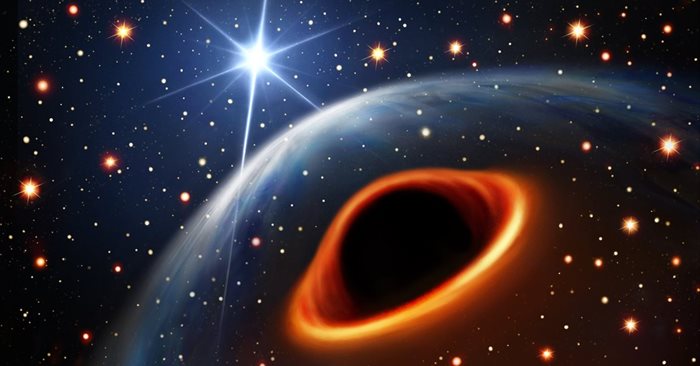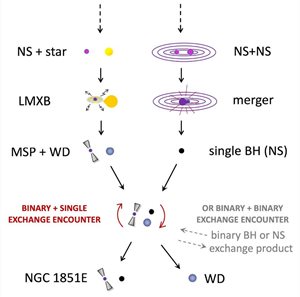An international team of astronomers, spearheaded by the Max Planck Institute for Radio Astronomy, has made a fascinating discovery using the MeerKAT radio telescope. They have identified an enigmatic object within the globular cluster NGC 1851. This massive entity is heavier than the heaviest known neutron stars, yet lighter than the lightest known black holes. It orbits a rapidly spinning millisecond pulsar, potentially marking the first discovery of a highly sought-after radio pulsar – black hole binary. This celestial pair could pave the way for new tests of Einstein’s general relativity.

The team used the sensitive MeerKAT radio telescope, located near Carnarvon in the Northern Cape Karoo. Source: SARAO
The research, which was published in the Science journal, talks about a pair of big, compact stars in a group of stars called NGC 1851. This group is in the southern constellation Columba.
The team used the very sensitive MeerKAT telescope, located just outside the Northern Cape town of Carnarvon, and some powerful equipment from the Max Planck Institute for Radio Astronomy. With these tools, they were able to pick up very faint signals from one of the stars.
Rui Lopes and Jaimin Patel 18 Jan 2024
This star, known as a radio pulsar, spins at over 170 revolutions per second. It sends out regular signals that are like the ticking of a clock. By watching tiny changes in this frequency, the team could measure very accurately how the star moves in its orbit.
Special environment
The team thinks that this big object and its partner, the fast-spinning star, were formed in a very unusual way. This could only happen because of the special environment they’re in. They live in a place called NGC 1851, which is a crowded group of old stars where stars often bump into each other or even crash together.
The scientists believe that this big object was created when two neutron stars collided.
Before the current pair of stars was formed, the spinning star (radio pulsar) first got material from another star. This process helped the pulsar to spin at its current speed. The scientists think that this other star was then swapped with the current big object in a swap event.
“This is the most exotic binary pulsar discovered yet,” says Thomas Tauris from Aalborg University, Denmark. “Its long and complex formation history pushes at the limits of our imagination.”

An artist’s impression of the system assuming that the massive companion star is a black hole. The brightest background star is its orbital companion, the radio pulsar PSR J0514-4002E. The two stars are separated by 8 million km and circle each other every 7 days. Source: Daniëlle Futselaar (artsource.nl)
Black hole mass gap
Neutron stars are super dense leftovers from a supernova explosion. They can only get so heavy before they collapse. It’s often thought that when they collapse, they become black holes, which are so strong that even light can’t escape them.
The lightest black holes are about 5x heavier than the Sun, which is much heavier than the 2.2x the Sun’s mass needed for a neutron star to collapse.
This creates what’s known as the black hole mass gap. The nature of objects in this gap is still a mystery because we’ve only caught brief glimpses of such objects in distant cosmic events.
The discovery of a radio pulsar-black hole binary system allows us to test the Einstein’s theory under extreme conditions. It also gives us a chance to study objects in the black hole mass gap, which can reveal more about the nature of compact objects and the transition from neutron stars to black holes.
Quantum gravity
This could uncover new relativistic effects and even shed light on quantum gravity – a theory that tries to reconcile general relativity with quantum mechanics. In essence, this discovery opens up new avenues for exploring the Universe and testing our understanding of it.

Potential formation history of the radio pulsar NGC 1851E and its exotic companion star. Source: Thomas Tauris (Aalborg University/MPIfR
While the team cannot conclusively say whether they have discovered the most massive neutron star known, the lightest black hole known or even some new exotic star variant, what is certain is that they have uncovered a unique laboratory for probing the properties of matter under the most extreme conditions in the Universe.
“We’re not done with this system yet,“ says Arunima Dutta. “Uncovering the true nature of the companion will a turning point in our understanding of neutron stars, black holes, and whatever else might be lurking in the black hole mass gap!”
This discovery is part of the Transients and Pulsars with MeerKAT (TRAPUM) project, an ongoing survey using the MeerKAT radio telescope. To date, TRAPUM and its sister projects have discovered more than 200 pulsars with MeerKAT.


































